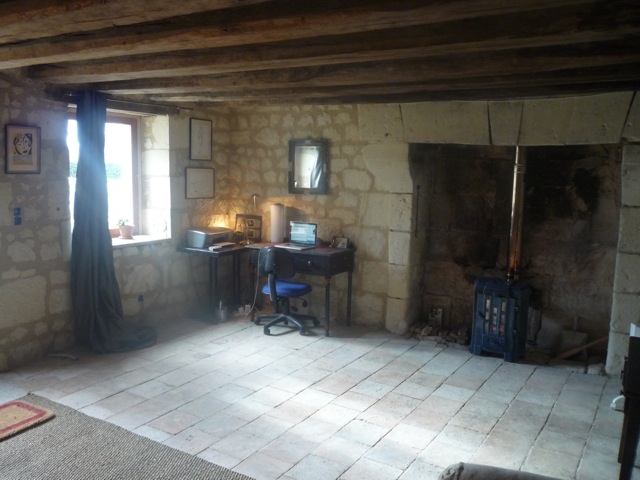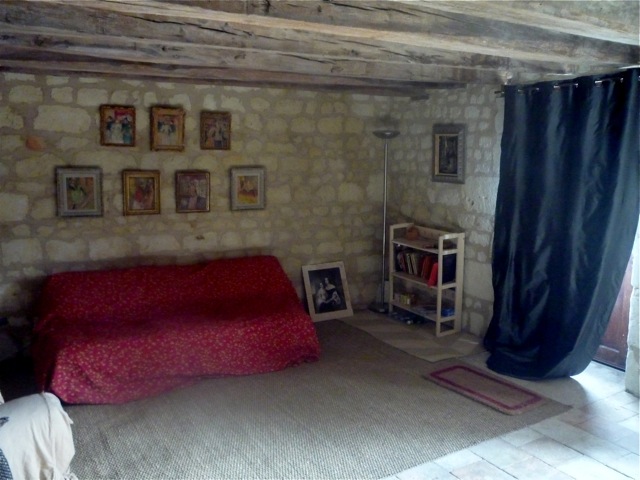I sat perched on a stool in a studio, my back facing a green screen and my front facing a huge video camera flanked by blinding lights. To my right was a bag of clothes and shoes I had brought as options for my author interview. Erin, who was in charge of the HarperCollins shoot, had chosen the only non-black items in the bag, a plum-colored shell topped with a red wildly-patterned cardigan I hadn’t dared wear since I bought it a few months before in Rio. Since the shoot would be from waist-up the pants and shoes I had brought didn’t matter.
Erin touched up my makeup while she briefed me on procedure. “I’ll stand to the left of the camera,” she said, “and ask you the questions, but the viewer will only hear you answering them. Just look at me, don’t look into the camera.” She clipped a microphone to my top and then glanced towards Melissa, one of my editors, who was looking at a monitor in the tech booth.
“Looks good!” Melissa yelled.
“Can you freeze-frame what you see so I can come look?” I asked nervously. The last time someone else had done my makeup, I had ended up looking like a cross between an alien and Lady Gaga with a hangover.
“Trust us,” Melissa responded. “You look great.”
The cameraman, named “Scooter” or some other cameraman-appropriate name, called, “Rolling!” and Erin asked me the first question. I looked at her. I looked at the camera. And I didn’t have a clue what to say.
A week before, my editor Tara had written me saying, “Since you’re in the States, why don’t we go ahead and shoot your video.” I agreed, and she sent me some sample questions to look over. But since we were on vacation, staying in a one-bedroom apartment, and I was watching the kids full-time while Laurent visited his wine customers, I hadn’t had much time to look at them. I told myself that it was better anyway not to be too prepared – my answers would sound more natural.
Oh man, had I been wrong. I sat there in the blinding lights and my brain was completely empty, besides one thought: Where’s the emergency exit?
Erin prompted me again, “Tell us what you’re story’s about.”
I started a rambling answer, and then all of a sudden the Publisher’s Weekly article about my book sale popped into my head, and I quoted one of their well-crafted sentences word-for-word.
“Great!” Erin said.
Why oh why didn’t I memorize my answers? I thought, beginning to feel genuinely panicky.
“Tell us what attracts Kate and Vincent to each other,” Erin continued.
Good question, I thought. Why is anyone attracted to anyone else? And then, in my mind, I started getting all existential and couldn’t come up with an answer that didn’t sound either 1. like a science class on “survival of the species” (the peahen prefers the peacock with the most beautiful tail so that she can have bigger, stronger peahen babies) OR 2. totally cynical (they’re both so ridiculously beautiful that of course all they want to do is jump on each other).
I finally spit out something about Kate looking for someone to help her escape her grief after her parents’ death. She is self-aware enough to know she’s using Vincent as an emotional crutch, but decides that that’s okay. Vincent, however, doesn’t understand why he is falling for Kate. “You know…because he’s a guy,” I say, thinking out loud, “and guys are so clueless.” I gasped and looked straight into the camera lens at Scooter – “Except for you of course, Scooter! I’m sure you’re not clueless.” I groaned, and yelled, “Cut!”
And the rest of the interview continued in the same confused deer-in-the-headlights vein. Finally Erin said, “Okay, I think we’re done.”
“But didn’t you want to go back to that first question that I couldn’t answer?” I asked, suddenly worried that there wasn’t one usable thing on tape.
“No, that’s fine,” she said. “I think we’ve got enough to work with. Our film editors will be able to take out the pauses and ‘ums’ and make it look fabulous. They’re geniuses, trust me.”
“Genius isn’t good enough. They’ll have to be gods,” I muttered, unclipping my microphone.
“Wait!” Erin said. “We need to tape a few clips. Now, I need you to look straight into the camera and say, ‘Hi Barnes and Noble customers. I’m Amy Plum, author of DIE FOR ME.’”
“What?” I gasped, confused. “What for?”
“The booksellers put it on their websites so customers can ‘meet’ the author.”
“Okay,” I said. And, feeling completely ridiculous, I looked straight into the camera and said, “Hi Barnes and Nobles customers. I’m Amy…” I had to think for a second. I had never said my pen name out loud. And I had been thinking about my book as SLEEPWALKING for so long that I couldn’t remember the new title.
“It’s Barnes and Noble,” Erin corrected, “Noble with no ‘s’, not Nobles”.
“Oh, right. Hi Barnes and Noble customer. I’m…”
“Customers…plural,” she said, “Barnes and Noble customers”.
My face felt like plastic as I smiled and looked into the lights and said my new name and book title over and over for the customers of Barnes and Noble, Amazon and Borders. On my way out Melissa, Erin and Scooter did their best to convince me the shooting hadn’t been a total train wreck. I was grateful, but didn’t believe them for a second.
Standing outside the building, I wondered what to do next. I didn’t want to go back to Laurent and my kids just yet. I would be a nervous wreck. What I really needed was a shoulder to cry on.
I pulled out my phone. “Lawrence? It’s me. I’m at 53rd and Madison. Are you anywhere nearby?” Fifteen minutes later, I was backstage at a drag queen bar called Lips, crying to an old friend as he transformed into his alter-ego, “Evangeline”. He listened to my story while he applied false eyelashes and donned a cherry-print dress for his Katie Perry number in that night’s show.
“It can’t have been that bad,” he said, squeezing me tightly against his bedazzled corset. “It was worse,” I moaned. “I looked as wooden as a dummy – might have well had someone’s hand up my back making my mouth move…blah…blah…blah.”
“Oh honey,” said Frankie Cocktail, Lips’s long-time bartender, straightening his foot-high wig. He held out a Kleenex in sympathy. “I hate being in front of a camera. Being on stage is hard enough, but knowing that your every move is being immortalized for posterity, ugh – I just blank out every time.”
“A drag queen who hates cameras,” I sniffled, smiling.
“I know,” he said. “We all have our little foibles.” He patted my hand, and went back to the bar, while Lawrence/Evangeline — now looking strikingly Katie Perry-ish — leaned in for a hug. “Well, I think you’re wonderful,” he said, “even if you did screw up your one and only chance to make a good impression on your fans.”
“Lawrence!” I yelled.
“Just kidding, sweetie. You’ve always been too hard on yourself. I’m sure you were fine.” He left a cherry-red lipstick mark on my cheek and began laying out dresses and wigs for his costume changes. My phone rang.
It was Laurent calling from Brooklyn. “Lucia just dropped a huge rock on her big toe. It might be broken. There’s blood everywhere, and she’s crying for you.” I hung up and made my way outside to look for a taxi.
Back to real life, I thought. Kids, naptimes and skirmishes over eating vegetables. No boardrooms, no interviews, and NO cameras. At that moment, standing on a street corner in the middle of New York City, “real life” had never sounded so good.
--------------------------------------------------------------------------------------------------------












